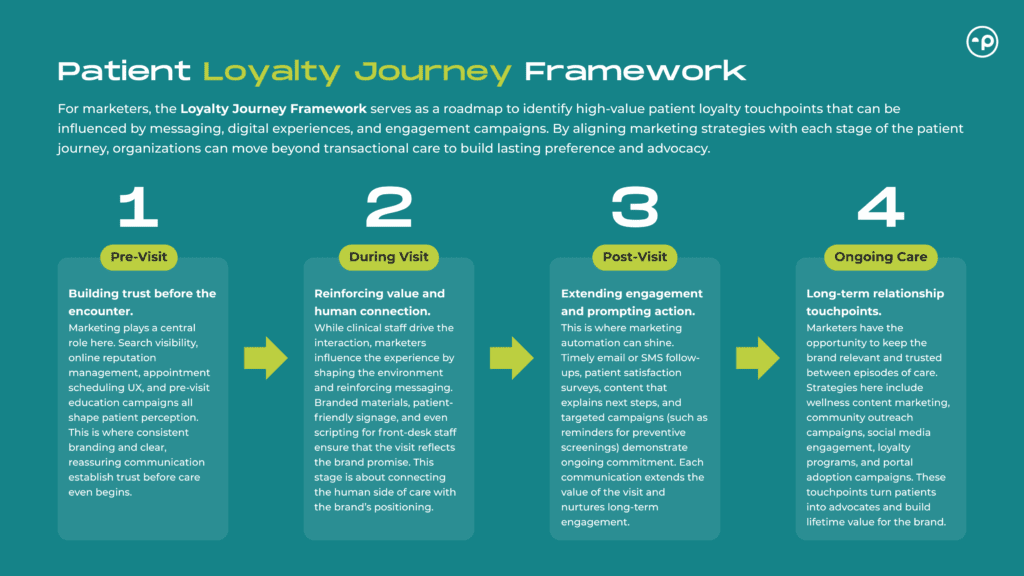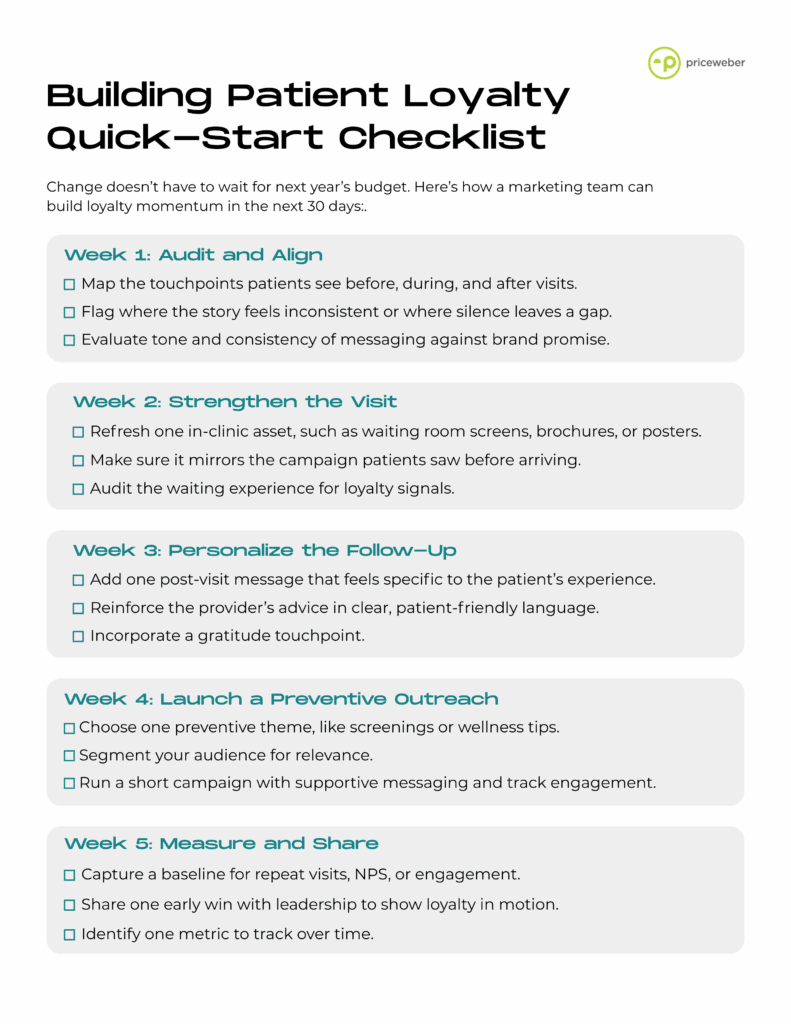
Creating Patient Loyalty Touchpoints That Matter: A Playbook for Healthcare Marketers
“I’ve learned that people will forget what you said, people will forget what you did, but people will never forget how you made them feel.” – Maya Angelou
We’ve all run across this quote at some point, but it’s especially applicable here. This sentiment is a reflection of how healthcare marketers should approach each patient touchpoint they’re responsible for. Patients may not recall every detail, but they remember how your healthcare brand made them feel from start to finish.
Every touchpoint, from emails to waiting room screens, either builds confidence or erodes it. And when the appointment ends, the story doesn’t. Patients keep remembering, comparing, and deciding whether they felt seen and supported.
That’s why loyalty matters so much in healthcare. It’s an ongoing conversation shaped by multiple moments along the way.
In this edition of Vital Signs, we’re sharing our playbook on how healthcare marketers can help their brand create meaningful patient touchpoints before, during, and after the visit.
KEY TAKEAWAYS
- Patients may not remember every detail of what was said or done, but they remember how your brand made them feel. Every touchpoint should reinforce trust and care.
- From pre-visit emails to waiting room screens, each interaction either builds confidence or erodes it. Marketers must see the entire journey as part of brand storytelling.
- The patient journey doesn’t end at checkout. Loyalty is built across pre-visit, during-visit, post-visit, and ongoing engagement.
- Patients expect reminders. Loyalty is created when outreach feels personal, contextual, and human.
- Preventive campaigns, wellness content, and loyalty-style engagement keep your brand present even between visits. Consistency positions your organization as a partner in long-term health.
- Don’t overwhelm leadership with endless KPIs. Track the metrics that reflect true loyalty like repeat visits, retention, NPS, review/referral volume, and more.

Play #1: Build Trust Before Check-In
Pre-Visit Touchpoints
What It Is
Here’’s another popular quote for you: “You never get a second chance to make a first impression.”? That’s how you need to think about this first set of touchpoints—as the initial building blocks of patient loyalty. They’re designed for interactions that happen after scheduling but before arrival. These might include confirmations, reminders, educational content, or warm introductions to the care team. For marketers, this is where that patient journey you’ve worked so hard to map out begins. Every message sets expectations and shapes perception.
Why It Works
Patients step into your organization carrying two things: emotion and judgment. If they’ve already experienced a pre-visit process that feels rushed or indifferent, they’re bringing that prejudice along. Successful pre-visit touchpoints act as a prelude that positions you as a trusted partner from the get-go. This is brand management at its finest. It’s the difference between a patient who arrives ready to engage and a patient who arrives guarded.
How to Run It
Think of the journey between scheduling and arrival as a campaign and apply the same logic.
- What messages will the patient receive?
- In what order?
- How do they reinforce the brand promise of the organization?
As always, work smarter, not harder. Use a mix of automated systems and human touches. A simple “”What to Expect”” email can be automated. A welcome video from the provider can be pre-recorded while still feeling highly personal. Whatever the assets, the sequence should deliver clarity and reassurance, not clutter. And every touchpoint should align with your positioning as a patient-centered practice.
Pro Tip: Think beyond reminders. (Patients already expect them!) True loyalty is built by personalization. In addition to using the patient’s name, reference their upcoming visit type or offer one practical tip that eases their specific preparation. Plant the seeds of lifetime loyalty using small signals that the organization sees them as individuals, not slots on a schedule.
Play #2: Reinforce Value in the Moment
During the Visit Touchpoints
What It Is
This is the point where those campaigns and brand promises meet reality. Patients are sitting in the waiting room at full attention. Even if they’re scrolling on their phones or leafing through an outdated magazine, they’re still aware. Every word, every piece of content, every scrap of messaging inside those walls can either strengthen or weaken loyalty. While you may not be able to influence all touchpoints, you can certainly look at their experience through your marketing lens.
Why It Works
In this phase, patients walk in with a heightened awareness of trust signals. They’ve given up part of their day to be questioned, poked, and prodded, after all. Is it worth it? In this moment, they’re searching for confirmation that they made the right choice. This gives you a unique opportunity to reinforce your brand messaging. Marketing takes months of building trust at a distance. The visit is where that trust is tested face-to-face.
How to Run It
Treat appointments like branded touchpoints. Create content that fills each moment with value. Waiting room screens, handouts, short videos, digital guides—these are all channels that present countless opportunities. Use them! A checklist someone can hold in their hands is physical reassurance that you’re their partner in this. A two-minute video that explains what to expect during a specific recovery can be more powerful than a polished but generic billboard. The goal is simple: make patients feel informed and cared for in real time.
Pro Tip: Give patients something to take with them, like a printed summary, a quick-reference card, or a digital link delivered right after the visit. That takeaway piece becomes a reminder of the visit and an extension of your brand.
Play #3: Extend Engagement and Prompt Action
Post-Visit Touchpoints
What It Is
The post-visit phase is the patient’s bridge back to your brand; the messages that arrive after they walk out the door. Things like follow-ups, reminders, surveys, thank-you notes, and educational content all fall into this category. Unfortunately, these touchpoints often get handled by default. They’re sent at the push of a button, and then it’s on to the next appointment. While your input and access to every message might be limited, you should still find ways to help keep that brand connection going strong.
Why It Works
Post-visit touchpoints work because they carry the brand beyond the clinic walls. This is where patients decide if the experience was a one-time transaction or the start of an ongoing relationship. A clear next step gives them confidence in what to do, and confidence is what builds trust. When communication feels intentional and consistent with the brand promise, patients are more likely to return. Beyond that, they’re more likely to share positive reviews and recommend your organization to others.
How to Run It
Map the outreach patients receive after their appointments. Run multiple scenarios with multiple types of patients. Put yourself in their shoes. How are you feeling? Are you getting the information and next steps you need? Is communication clear? This is your opportunity to treat after-appointment education as an extension of your brand storytelling. Focus on touchpoints that are a blend of personalized, helpful information aligned with your brand identity.
Pro Tip: Post-visit messaging should always answer two questions: does the patient feel recognized, and do they know exactly what to do next? Double-check yours.
Play #4: Preventive Campaigns and Loyalty-Style Engagement
Ongoing Care
What It Is
Ongoing engagement is the steady heartbeat of a patient relationship. It’s the outreach that happens when no appointment is on the calendar. Preventive campaigns, wellness content, seasonal reminders, and community updates all fall into this category. These touchpoints keep the brand present during quiet periods, reminding patients that care is continuous, not episodic.
Why It Works
This phase works because it positions your brand as more than a problem-solver. Instead of showing up only when patients are sick or need a procedure, you show up with guidance that helps them stay well. Preventive campaigns prove you understand their long-term health journey, not just the visit in front of them. Loyalty-style engagement—messages that recognize their history with your brand—deepens that trust. The more patients feel cared for between visits, the more likely they are to stay, return, and advocate.
How to Run It
Build a calendar of preventive campaigns tied to patient needs and seasonal health moments. Frame them in the same voice as your brand campaigns so they feel like part of a consistent story. Segment your audience and tailor the outreach, whether it’s flu season reminders, lifestyle tips for managing chronic conditions, or invitations to wellness events. Balance educational content with relational touches, so it feels less like a broadcast and more like an ongoing conversation.
Pro Tip: Treat ongoing engagement like loyalty marketing, not health promotion. When patients see you as a partner in their everyday life, they stop comparing providers and start committing to yours.
Measurement: Proving Loyalty in Action
When it comes to loyalty, you don’t have to cross your fingers and hope for the best. Put loyalty-based metrics in place and start tracking. The mistake we see a lot of marketers make is drowning in dozens of numbers that don’t tell a clear story. A better approach is to track a small set of metrics that reveal whether patients are truly engaging and advocating.
The metrics that matter
- Repeat Visits
- Retention Rate
- Churn
- NPS (Net Promoter Score)
- Review Volume + Rating
- Referral Volume
- Email Engagement
- Portal Activity
- Survey Response Rates
- Event/Wellness Participation
- Lifetime Value (LTV)
- Service Line Cross-Utilization
- Preventive Uptake
Pro Tip: Don’t overwhelm leadership with all of these at once. Instead, frame them as a menu of options, then choose 4–6 that best connect to your organization’s strategy.
Building Patient Loyalty Quick-Start Checklist
Change doesn’t have to wait for next year’s budget. Here’s how a marketing team can build loyalty momentum in the next 30 days:
Week 1: Audit and Align
- Map the touchpoints patients see before, during, and after visits.
- Flag where the story feels inconsistent or where silence leaves a gap.
- Evaluate tone and consistency of messaging against brand promise.
Week 2: Strengthen the Visit
- Refresh one in-clinic asset, such as waiting room screens, brochures, or posters.
- Make sure it mirrors the campaign patients saw before arriving.
- Audit the waiting experience for loyalty signals.
Week 3: Personalize the Follow-Up
- Add one post-visit message that feels specific to the patient’s experience.
- Reinforce the provider’s advice in clear, patient-friendly language.
- Incorporate a gratitude touchpoint.
Week 4: Launch a Preventive Outreach
- Segment your audience for relevance.
- Choose one preventive theme, like screenings or wellness tips.
- Run a short campaign with supportive messaging and track engagement.
Week 5: Measure and Share
- Capture a baseline for repeat visits, NPS, or engagement.
- Share one early win with leadership to show loyalty in motion.
- Identify one metric to track over time.

Patient loyalty is built in the moments between first impression and long-term relationship. Every touchpoint, from before the first visit through ongoing care, can either strengthen or weaken that bond. Marketers who see the patient journey as a loyalty engine create more than satisfied patients. They create advocates.
If you’re ready to sharpen your strategy, tighten your touchpoints, and turn loyalty into measurable growth, partner with our healthcare marketing experts. As a full-service agency, PriceWeber help health systems transform everyday interactions into lasting connections.
Let’s build the kind of loyalty that keeps patients coming back. Contact us here or call us at 502-499-4209 to get started.
Our Articles Delivered
Signup to receive our latest articles right in your inbox.



